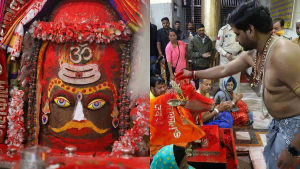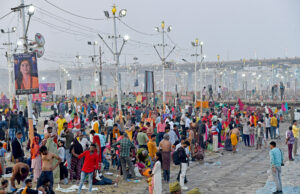
By PRAKHAR TRIPATHI
The journey from Delhi to Bhopal is marked by signposts quantifying distance—700 km, 500 km, 200 KM, 0 km—each a reminder of how units govern our perception of reality. Just as we measure time, money, or emotions, these metrics structure our existence. Yet Hinduism posits a profound truth: deity worship transcends this framework of units, offering a path where equations dissolve, leaving only the pure essence of being.
The Tyranny of Units
Units define human experience. A farmer measures land in acres, a trader calculates profit in rupees, and a traveler tracks distance in kilometers. These constructs, while practical, fragment reality into digestible parts. Like signboards reducing Bhopal to numbers, units condition us to perceive life through transactional logic—this for that, effort for reward. But Hinduism challenges this reductionism. If thirst necessitates water and hunger demands food, the existence of beings implies the divine—not as a separate entity but as the foundational fabric of existence. God, in this view, is not a “requirement” but the very ground of being, as inherent as breath.
Deity Worship: Shattering the Metrics
Hinduism’s embrace of deity worship is not about idolizing stone or metal but dissolving the boundaries of measurable reality. Consider the ritual of puja: offerings of flowers, incense, and light are not transactional exchanges (units of devotion for divine favor) but acts of surrender. The deity—a manifestation of the formless Brahman—becomes a mirror, reflecting the worshiper’s own infinite nature.
Beyond Transactional Logic: Unlike buying groceries or paying bills, deity worship operates outside the give-and-take paradigm. A devotee doesn’t “earn” grace through quantified prayers but aligns with a cosmic rhythm where distinctions (self/God, sacred/profane) collapse.
The Illusion of Separation: Units thrive on duality—near vs. far, self vs. other. Deities, as embodiments of Brahman, dismantle this illusion. Just as the signposts to Bhopal vanish upon arrival, worship reveals the divine not as distant but as the immanent core of existence.
Existence Without Equations
The Upanishads declare, “Tat Tvam Asi” (Thou art That). This non-dual truth asserts that the worshiper and the worshipped are one. Deities serve as bridges to this realization. When a devotee gazes at Krishna’s flute or Shiva’s trident, they aren’t venerating objects but recognizing symbols of a reality beyond symbols—a realm where hunger and satisfaction, distance and arrival, cease to oppose each other.
This is why Hindu rituals often culminate in arati: the circling of light before the deity. The flame’s movement mimics the cyclical nature of time and space, yet its essence—pure, unchanging radiance—mirrors the self. Units of time (seconds, minutes) fade; what remains is being, unmeasured and whole.
Conclusion: The Signposts Dissolve
The road to Bhopal ends when the traveler arrives, rendering kilometers irrelevant. Similarly, deity worship is the journey where units of devotion, doubt, and desire dissolve into the infinite. Hindus don’t worship deities to reach God but to realize that God is the reach itself—the thirst that is the water, the hunger that is the food, the being that is the divine. In this space, all equations cease, and existence stands unveiled, unitless and complete.
(The author is working throughout the country as a carrier of Indian culture)







